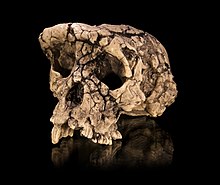Toumai
|
Sahelanthropus "Toumaï" Temporal range: Late Miocene, 7-6.2 Ma |
|
|---|---|
 |
|
| Cast of a Sahelanthropus tchadensis skull (Toumaï) | |
| Scientific classification | |
| Kingdom: | Animalia |
| Phylum: | Chordata |
| Class: | Mammalia |
| Order: | Primates |
| Family: | Hominidae |
| Subfamily: | Homininae |
| Tribe: | Hominini |
| Genus: |
†Sahelanthropus Brunet et al., 2002 |
| Species: | †S. tchadensis |
| Binomial name | |
|
Sahelanthropus tchadensis Brunet et al., 2002 |
|
Sahelanthropus tchadensis is an extinct homininae species (and is probably the ancestor to Orrorin) that is dated to about 7 million years ago, during the Miocene epoch, possibly very close to the time of the chimpanzee–human divergence. Few specimens are known, other than the partial skull nicknamed Toumaï ("hope of life").
Existing fossils include a relatively small cranium named Toumaï ("hope of life" in the local Daza language of Chad in central Africa), five pieces of jaw, and some teeth, making up a head that has a mixture of derived and primitive features. The braincase, being only 320 cm³ to 380 cm³ in volume, is similar to that of extant chimpanzees and is notably less than the approximate human volume of 1350 cm³.
The teeth, brow ridges, and facial structure differ markedly from those found in Homo sapiens. Cranial features show a flatter face, u-shaped dental arcade, small canines, an anterior foramen magnum, and heavy brow ridges. No postcranial remains have been recovered. The only known skull suffered a large amount of distortion during the time of fossilisation and discovery, as the cranium is dorsoventrally flattened, and the right side is depressed.
Sahelanthropus tchadensis may have walked on two legs. However, because no postcranial remains (i.e., bones below the skull) have been discovered, it is not known definitively whether Sahelanthropus was indeed bipedal, although claims for an anteriorly placed foramen magnum suggests that this may have been the case. Upon examination of the foramen magnum in the primary study, the lead author speculated that a bipedal gait "would not be unreasonable" based on basicranial morphology similar to more recent hominins. Some palaeontologists have disputed this interpretation, stating that the basicranium, as well as dentition and facial features, do not represent adaptations unique to the hominin clade, nor indicative of bipedalism; and stating that canine wear is similar to other Miocene apes. Further, according to recent information, what might be a femur of a hominid was also discovered near the cranium—but which has not been published nor accounted for.
...
Wikipedia
